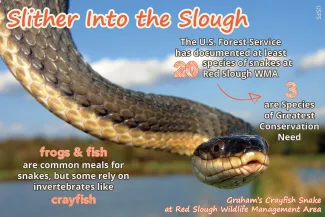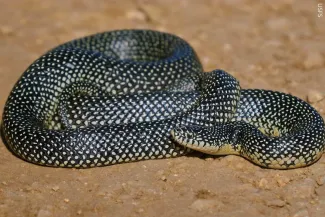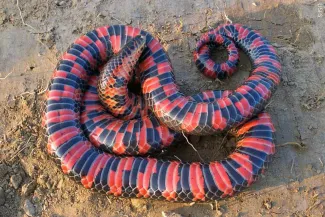Spend much time wildlife-watching outdoors and you’re bound to eventually bump into a snake. While some may not include the encounter on their days’ Top 10 list of memories, others may snap a photo to share far and wide. Love ‘em or hate ‘em, snakes are a lasting part of our natural world.
Nearly 50 species of snakes can be found in Oklahoma, 84% of which are nonvenomous. They come in a variety of sizes, colors, and even personalities. One of our state’s snake hotspots, Red Slough Wildlife Management Area, is a great place to experience this diversity. The management area hosts 20 species – one-third of the snakes found in our state!

“Nearly half of our snake species are tied to water – and we have a lot of water,” said David Arbour, biological aid for the Wildlife Department. “This water means we have a grocery store of sorts for snakes – they feed primarily on the fish, tadpoles and frogs found in and around the water.”
Away from Red Slough’s wetlands, snakes can take advantage of more forested areas as well as the WMA’s restored pine-bluestem habitat. While frogs may still play a role in these upland snake’s diet, insects, rodents and even other snakes are more likely meals.

Speckled kingsnakes and other members of the kingsnake family are well known predators of other species of snakes. Kingsnakes are even able to kill and eat venomous snakes.
Snake Spotting
Because snakes are ectotherms – relying on the environment to control their internal body temperature – many species are most active during the warm spring and summer months.
“Early summer mornings are great times to look for snakes,” said Arbour. “Most species have cooled off during the night, and need to warm to their active temperature. It’s not uncommon to find them basking on warm rocks, sun-soaked logs and even the warm pavement or gravel road.”
“Most snakes are pretty wary, and will often slip into the water or find a burrow if you approach,” Arbour said. “It’s hard to get close for a photograph sometimes.” (Capturing reptiles at Red Slough WMA requires a Scientific Collector’s permit from the Wildlife Department and a Special Use permit from the Ouachita National Forest. Permits are not required to photograph the animals.)
While it’s common to see nonvenomous watersnakes near Red Slough’s wetlands, some of the WMA’s snakes aren’t as visible, even during the typical morning or evening basking shift. “We have two species of snakes – the gulf crayfish snake and western mudsnake – that are not only rare, but also really secretive.” Both snakes are highly aquatic; the crayfish snake feeds primarily on molting crayfish, the mudsnake primarily on amphiumas and sirens (salamanders restricted to the southeastern corner of the state).

Mudsnakes have a shiny black back, but a striking red and black checkerboard pattern on their belly.
Oklahoma’s summer temps may also factor into the snake’s visibility. Exceedingly hot temperatures can cause some of the WMA’s day-active species, like the Texas brownsnake, to shift to a more active nightlife.
Does Your Area Share Snakes with Red Slough?
Red Slough’s diversity attracts reptile enthusiasts and herpetology students from across Oklahoma and neighboring states, but they also share many species with the rest of the state.
“Perhaps two of our most common snakes, the plain-bellied and diamond-backed watersnakes are also extremely common in other areas of the state. They can be found near almost any permanent water,” Arbour said.
Other snakes common at Red Slough are represented statewide at a species level. “We have a subspecies of the eastern racer known as the southern black racer,” Arbour said. The distinguishing feature of this subspecies is the background color. “Racers found at the Slough and the eastern quarter of the state are black in color." Eastern yellow-bellied racers are the subspecies found in the rest of the state and are olive-brown or yellowish.
Regardless of their range in the state, there are ways to avoid undesirable snake encounters. One of the best ways is to remain aware of your surroundings. Paying attention to where your hands and feet go while hiking or scrambling over rocks or boulders may help you avoid stepping on or unintentionally handling a snake. Similar attention at the water’s edge, or around tree limbs or shrubs overhanging the water, may help you keep a respectable distance from a snake. The majority of our snakes are not aggressive and will most likely try to escape your presence, or remain motionless and unnoticed.